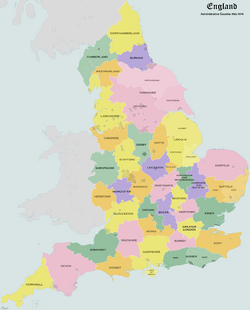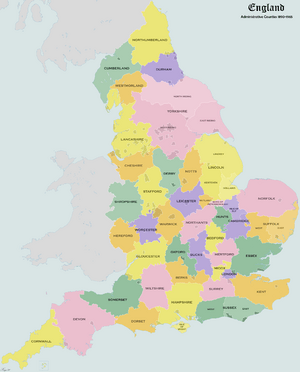Administrative counties of England facts for kids
Quick facts for kids Administrative county (England) |
|
|---|---|

The administrative counties as they were when abolished in 1974
|
|
| Category | Administrative county |
| Location | England |
| Found in | County |
| Created by | Local Government Act 1888 |
| Created | 1889 |
| Abolished by | Local Government Act 1972 |
| Abolished | 1974 |
| Populations | 25,000–4.2 million |
| Government | County council |
| Subdivisions | Rural district Urban district Municipal borough |
Administrative counties were special areas in England used for how local places were run. They existed from 1889 to 1974. These areas were set up by a law called the Local Government Act 1888.
This law created elected groups called county councils for each area. Some of England's older, larger areas (called historic counties) were split into several administrative counties. Each of these new counties had its own county council. The administrative counties were used until 1974. Then, a new system of metropolitan and non-metropolitan counties took their place. This change happened because of the Local Government Act 1972.
Contents
How County Councils Started
In 1888, the government, led by Prime Minister Lord Salisbury, created county councils across England and Wales. These councils looked after areas known as administrative counties.
Many larger towns and cities were given a special status called "county borough". This meant they had similar powers to administrative counties and could manage themselves.
Some big historic counties were divided for administrative reasons. These included Cambridgeshire, Lincolnshire, Northamptonshire, Suffolk, Sussex, and Yorkshire. There was also a special County of London administrative county. It covered the area we now call Inner London. The Isle of Wight became its own administrative county in 1890. Before that, it was part of Hampshire.
In 1894, a two-part system was set up for most areas. Administrative counties were divided into smaller parts. These were called urban districts, rural districts, and municipal boroughs. The County of London was also divided into metropolitan boroughs in 1900.
Over time, small parts of counties that were separated from the main area (called "exclaves") were mostly removed. This happened when county councils were given the power to change county borders. For example, the Measham area moved from Derbyshire to Leicestershire in 1897.
England's Administrative Counties (1890–1965)
The map below shows how the administrative counties and county boroughs looked between 1890 and 1965. Sometimes, when a county borough grew into land from a different county, maps would show that county as getting bigger.
The Local Government Act 1888 did not list all the administrative counties. It wasn't until 1933, with a new Local Government Act, that they were officially listed. The 1933 Act did not include county boroughs as administrative counties.
In official documents, the word "shire" was often left out. For example, Bedfordshire was called "the administrative county of Bedford." The council for Northamptonshire was the "county council of Northampton."
How Local Areas Were Organized
This table shows how England was divided up at the county and district levels between 1899 and 1965.
| County level | Administrative county | Administrative county | County borough | County of London |
|---|---|---|---|---|
| District level | Rural district | Urban district or Municipal borough |
n/a | Metropolitan Borough |
| Parish level | Civil parish | n/a | n/a | n/a |
Changes to Borders Over Time
The borders of the administrative counties changed a lot. There were three main reasons for these changes:
- Towns growing across existing borders.
- New county boroughs being created or existing ones getting bigger.
- Removing small, separated parts of counties (exclaves).
As more people moved to towns, cities grew larger than ever before. These growing urban areas often crossed old county lines. The Local Government Act 1888 said that if a town area crossed a county border, the whole town would belong to the county where most of it was. This rule continued as urban districts and municipal boroughs expanded.
Some towns that were split by old borders, like Banbury and Tamworth, were later brought into one administrative county.
The size and population of administrative counties also became smaller as more county boroughs were created and expanded. By 1970, about 25% of England's population lived in county boroughs. A law in 1926 made it harder to create or enlarge these boroughs.
Many administrative counties had "exclaves" when they were first created. These were small pieces of land belonging to one county but surrounded by another. Most of these were removed in the 1890s. For example, the borders of Gloucestershire, Worcestershire, and Wiltshire were redrawn in 1931 to fix many of these separated areas.
The Creation of Greater London
For many years, people discussed how to manage local government as England became more urban. Ideas for expanding county boroughs or creating larger urban counties were talked about. But nothing major happened until 1963.
In 1965, a new law created Greater London. This was a unique new area that replaced the old County of London. It also took in three surrounding county boroughs and parts of Surrey, Kent, Essex, and Hertfordshire. Almost all of Middlesex county was absorbed into Greater London. The remaining parts of Middlesex went to Surrey and Hertfordshire.
Other changes also happened around this time. For example, the Soke of Peterborough and Huntingdonshire were combined to form Huntingdon and Peterborough. The original Cambridgeshire merged with the Isle of Ely to create Cambridgeshire and Isle of Ely.
England's Administrative Counties (1965–1974)
The map below shows the administrative counties and county boroughs just before they were replaced in 1974.
End of the Administrative Counties
In 1974, the administrative counties were officially stopped. This happened because of the Local Government Act 1972. They were replaced by a new system of metropolitan and non-metropolitan counties.
See Also
- Metropolitan and non-metropolitan counties of England
- Local Government Act 1888
- Local Government Act 1972



